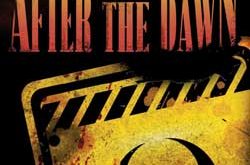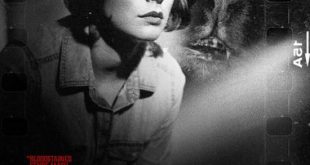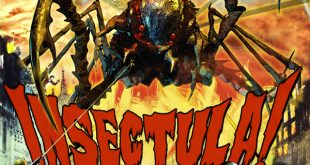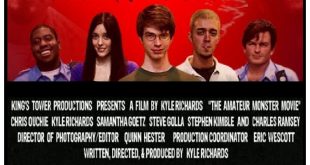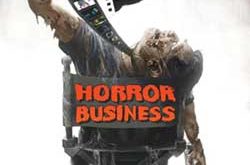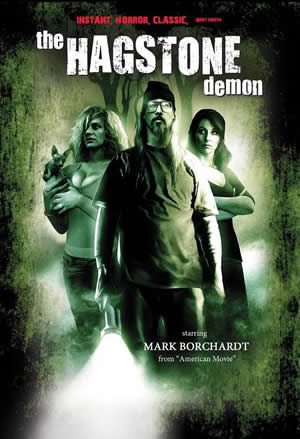 SYNOPSIS:
SYNOPSIS:
One year after the suicide of his late wife, Julie (Gizelle Erickson), Douglas Elmore (Mark Borchardt) takes up residence in an old apartment complex known as “The Hagstone” as the building’s caretaker. It’s temporary employment as the dwelling is declared unfit for living and the residents have only a few months to find somewhere else to live. As the days wear on, Douglas begins to see visions of Julie and things get complicated as he continues to help a homeless girl named Karna (Nadine Gross) who has squatted in the abandoned basement apartment. As things spiral out of his control during his investigation of the deaths in the Hagstone, he seeks the help of his brother-in-law, Father Carl Becker (Sasha Andreev), and a fellow tenant, Barbara Halloway (Cyndi Kurtz). Together they unravel the secrets of the Hagstone and the supernatural forces that seeks to escape its walls.
REVIEW:
The Hagstone Demon, as directed by Jon Springer, is an odd mix of Rosemary’s Baby and film noir, with a little bit of the Exorcist (or perhaps rather Beyond the Door) thrown in for good measure. It’s a little unclear. Shot in black and white, the film treats its hero as a drunken, slacker version of Mickey Spillane’s Mike Hammer. Springer makes this work for most of the film and plays at reversal of convention by having the flashbacks filmed in full color. The acting is better than usual for a low budget film and the minimal effects are simple but effective benefiting heavily from the black and white approach. The story is low on action and relies on its mystery and its interesting characters to carry the film. For the most part it succeeds, but flounders in a lack of conflict and emotion. It’s never truly scary but it does have a creepy air about it for its entirely due to a combination of pace, location and de-saturation of color.
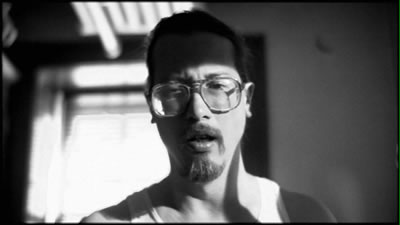 Jon Springer brings an interesting style to The Hagstone Demon that is reminiscent of Night of the Living Dead – especially when Douglas visits his dead wife’s grave. Throughout the film, he exhibits a natural eye for black and white, intimate. low-budget film making. It provides the film its strength and draw. Filming the flashbacks in full color is an interesting choice that contrasts the past life where hope is still affordable to the present where Douglas’ life is drowning is sorrow and alcohol. He is not entirely successful in his black and white approach; in a few scenes the light and shadow serve only to obstruct the view or the story and a worm’s view shot is out of focus and out of place. Elsewhere, the film noir story telling, in tone, in narration and in cinematography, make this film what it is, especially when Douglas is out and about investigating Karma’s whereabouts and actions.
Jon Springer brings an interesting style to The Hagstone Demon that is reminiscent of Night of the Living Dead – especially when Douglas visits his dead wife’s grave. Throughout the film, he exhibits a natural eye for black and white, intimate. low-budget film making. It provides the film its strength and draw. Filming the flashbacks in full color is an interesting choice that contrasts the past life where hope is still affordable to the present where Douglas’ life is drowning is sorrow and alcohol. He is not entirely successful in his black and white approach; in a few scenes the light and shadow serve only to obstruct the view or the story and a worm’s view shot is out of focus and out of place. Elsewhere, the film noir story telling, in tone, in narration and in cinematography, make this film what it is, especially when Douglas is out and about investigating Karma’s whereabouts and actions.
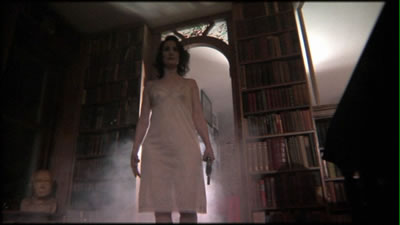 Mark Borchardt (American Movie: The Making of Northwester) takes a little getting used to at first coming across like an odd combination between Columbo and Jason Mewes’ Jay from Jay and Silent Bob. His narration is flat and monotone, but soon sets the tone and atmosphere to the film. In short time he becomes the likable, but quirky, hero the films desires. He displays an odd style of compassion for his tenants and an approach to the events in the film that is more of an observer than a participant. He becomes the audiences’ view of the story with a skewed eye into the world that populates the Hagstone building. Once the audience and the character sync into a shared pathos and a passive hero mode, Borchardt drives the other characters either by similarity in their off kilter behavior or in contrast setting those characters apart and more ‘real’ (Father Carl and Barbara).
Mark Borchardt (American Movie: The Making of Northwester) takes a little getting used to at first coming across like an odd combination between Columbo and Jason Mewes’ Jay from Jay and Silent Bob. His narration is flat and monotone, but soon sets the tone and atmosphere to the film. In short time he becomes the likable, but quirky, hero the films desires. He displays an odd style of compassion for his tenants and an approach to the events in the film that is more of an observer than a participant. He becomes the audiences’ view of the story with a skewed eye into the world that populates the Hagstone building. Once the audience and the character sync into a shared pathos and a passive hero mode, Borchardt drives the other characters either by similarity in their off kilter behavior or in contrast setting those characters apart and more ‘real’ (Father Carl and Barbara).
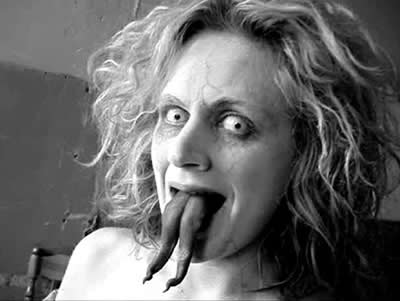 The story of The Hagstone Demon demands little in the way of special effects; but, when they are employed, they work due to the tone of the film. In color, many of the effects would have been silly and ineffective. Usually the effects are kept to a discovered body in the brownstone. A body discovered at the foot of a long staircase, blood dripping down the next flight of stairs, evokes the death of Detective Arbogast in Psycho. When the film takes a demonic left turn toward the end, the special effect begin to vary, ranging from silly (an obvious fake head spewing a supernatural liquid onto Barbara) to chilling (the demonic version of Mary Ann Riley in the basement crawlspace). The cat demon that stares down our heroes is straight out of most any Eighties low budget direct to video entry. Regardless, each fits the atmosphere established within the film’s environment.
The story of The Hagstone Demon demands little in the way of special effects; but, when they are employed, they work due to the tone of the film. In color, many of the effects would have been silly and ineffective. Usually the effects are kept to a discovered body in the brownstone. A body discovered at the foot of a long staircase, blood dripping down the next flight of stairs, evokes the death of Detective Arbogast in Psycho. When the film takes a demonic left turn toward the end, the special effect begin to vary, ranging from silly (an obvious fake head spewing a supernatural liquid onto Barbara) to chilling (the demonic version of Mary Ann Riley in the basement crawlspace). The cat demon that stares down our heroes is straight out of most any Eighties low budget direct to video entry. Regardless, each fits the atmosphere established within the film’s environment.
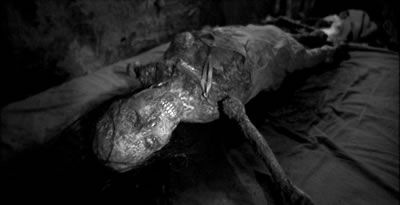 The Hagstone Demon revels in its black and white film noir foundation, its awkward narration and dialog, and its character in both story and cast. Never groundbreaking but not without invention, the film has a unique approach and tone worth noting. Weaving together a number of influences, the film feels familiar but not derivative. Borchardt, Nadine Gross, Cyndi Kurtz and the rest of the cast are raw and amateurish, but honest and authentic. Springer brings a distinctive eye and a blend of genres to the direction that glues the film together. The Hagstone Demon is a terrific low budget film, not as memorable or a groundbreaking as it could be, but solid and oddly effective.
The Hagstone Demon revels in its black and white film noir foundation, its awkward narration and dialog, and its character in both story and cast. Never groundbreaking but not without invention, the film has a unique approach and tone worth noting. Weaving together a number of influences, the film feels familiar but not derivative. Borchardt, Nadine Gross, Cyndi Kurtz and the rest of the cast are raw and amateurish, but honest and authentic. Springer brings a distinctive eye and a blend of genres to the direction that glues the film together. The Hagstone Demon is a terrific low budget film, not as memorable or a groundbreaking as it could be, but solid and oddly effective.
3 out of 5
The Hagstone Demon (2011)
 Horror News | HNN Official Site | Horror Movies,Trailers, Reviews
Horror News | HNN Official Site | Horror Movies,Trailers, Reviews
